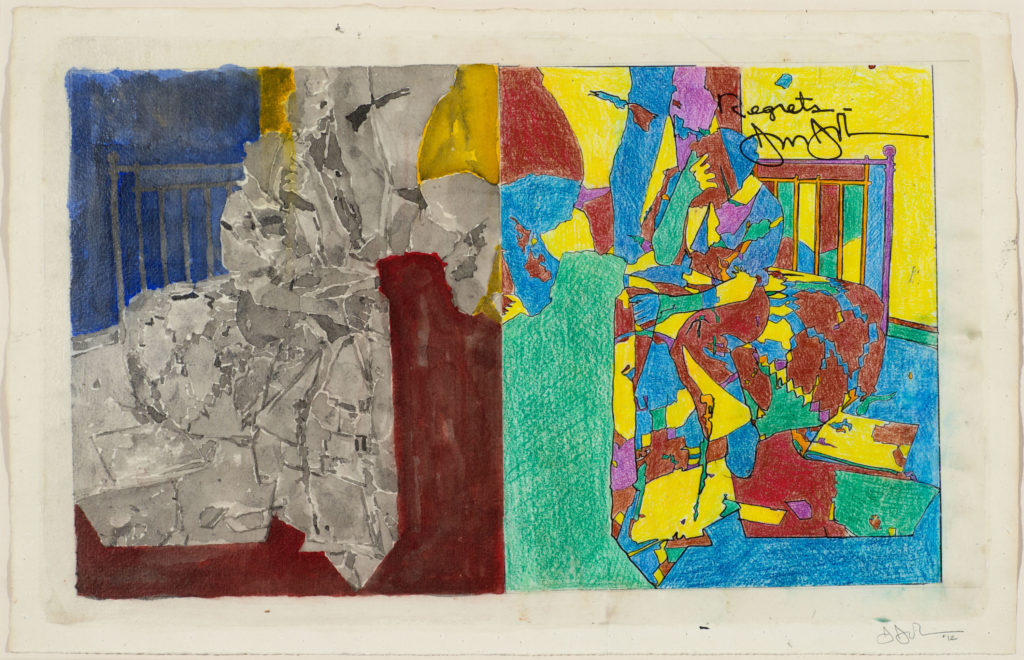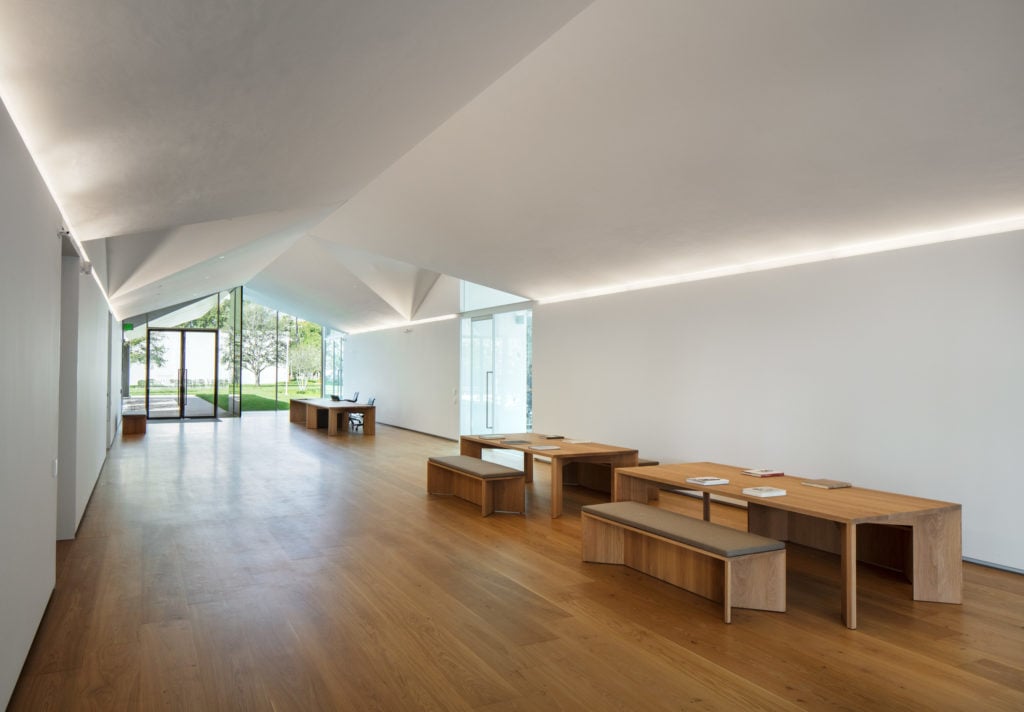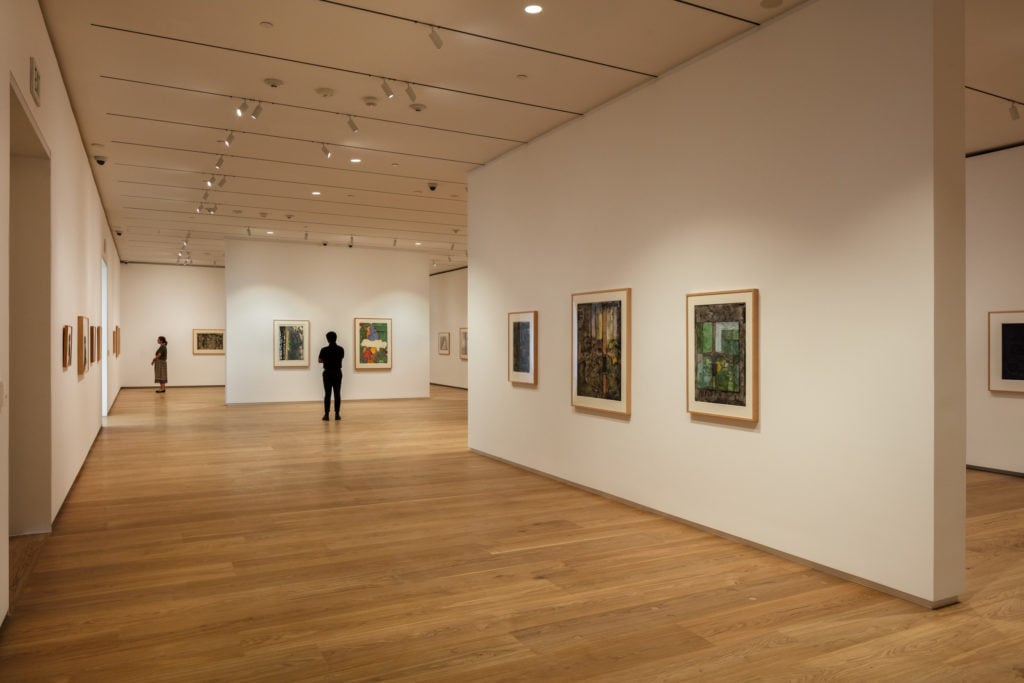Art World
The Menil Drawing Institute’s New $40 Million Building Opens in Houston With a Lofty Goal: To Redefine the Medium
The new institute is pushing the boundaries of what a drawing can be.

The new institute is pushing the boundaries of what a drawing can be.

Janelle Zara

In Houston’s newly opened Menil Drawing Institute, the exhibition “The Condition of Being Here: Drawings by Jasper Johns” features all of the titular artist’s signature motifs: American flags, targets, letters, and numbers. Some are outlined on paper in pencil or charcoal. Others are muddled in washes of ink and watercolor that pooled on sheets of plastic, forming cloudy gradients of opacity as they dried.
Alongside the 41 works, made between 1954 and 2016, there are instances where Johns used a paper towel as a canvas and ink alongside encaustic. There’s also an impression of the artist’s face, coated with charcoal and pressed against a sheet of paper.
These works “stretch the definitions of what drawing can be,” says Menil Collection director Rebecca Rabinow. This is what makes Johns an ideal artist to inaugurate the Menil Drawing Institute’s new home: a 30,000-square-foot, $40 million building designed by Los Angeles-based architects Johnston Marklee.
Thanks to the generosity of Houston’s stalwart base of private donors (whose names are engraved in bronze at the entrance in order of donation size), the institute’s building has become the first of its kind: one designed expressly to serve the exhibition, study, conservation, and storage of modern and contemporary drawings.

Jasper Johns, Study for Regrets (2012). The Menil Collection. ©2018 Jasper Johns/ Licensed by VAGA at Artists Rights Society (ARS), NY.
Since it was founded in 2007, the Menil Drawing Institute framed drawing as a central component to creative practice, but not one that was strictly defined by traditional notions of mark-making on paper.
“Artists draw any way they want, any way they can; definition is not their business,” curator Berenice Rose wrote in the catalogue essay of its first show, 2008’s “How Artists Draw: Toward the Menil Drawing Institute and Study Center.” Preceding the construction of the institute’s brick-and-mortar home, the show took place inside the main Renzo Piano-designed Menil Collection building, which included collages by Pablo Picasso and Max Ernst, crayon on paper works by Georges Seurat, and an American flag by Johns, done in watercolor and pencil.
Johns’s current show inaugurates the new building alongside hundreds of Roni Horn’s aphorisms, written on the gallery wall in different colored pens and pencils and different styles of handwriting—“AN ACHING VOID”; “one note johnny”; “save your breath”—the first in the institute’s series of site-specific drawings. Her use of pigments and cutouts will be the focus of the institute’s next two exhibitions in the spring and summer.
On the opposite wall, Ruth Asawa’s undulating wire sculpture Untitled (Hanging Six-Lobed, Discontinuous Surface with an Interlocked Top Section) (1956) hangs from the ceiling. And outside, Michael Heizer’s Rift and Dissipate carve lines into the adjacent plot of land, framed by weathering steel.
These are works that are emblematic of the institute’s central questions: “What is mark-making? Can it be suspended in space? Can it be on plastic? Can it incorporate found objects?” says Rabinow. “We would argue, yes.”

The interior of the Menil Drawing Institute. Photo by Richard Barnes, courtesy of the Menil Collection, Houston.
The airy white building subtly announces its devotion to drawing, while the sharp angles of the gabled roof and its eaves plainly bring to mind the creases in a folded sheet of paper. For the interior, the architects worked closely with the institute’s staff of art handlers, curators, and framers to resolve some of the technical obstacles often posed by museum drawing departments.
Minding the light-sensitivity of paper, for example, the angular ceiling and eaves diffuse light from the glass exterior walls, while the sunny interior courtyard keeps the corridors and offices brightly lit. In contrast to a museum, the institute is an “active place” of study and training, particularly for aspiring curators of drawing. There’s a light-filled room for reading, a cozy lounge for drawing, and a conservation lab decked out with new equipment.
“It’s exciting to have this much dedicated space,” says paper conservator Jan Burandt, who’ll be using her new high-power microscope to analyze how colors change over time. (It helps the institute develop preservation strategies for contemporary drawing materials, which are even more varied now than they were at the height of Johns’s career.)
The exhibition spaces are also scaled down, a response to the many times drawings have been swallowed by larger galleries meant for painting and sculpture. “The intimacy is custom-fit like a glove,” says Mark Lee, a principal of the architecture firm Johnston Marklee.

The interior exhibition space of the Menil Drawing Institute. Photo by Richard Barnes, courtesy of the Menil Collection, Houston.
Intimacy is the optimum word. Drawings perform a different kind of engagement, according to Rabinow, who notes how the relative affordability of the medium allows the collection to acquire works by a greater variety of artists. They also present a dimension of an artist’s creative practice that overlaps with those of other professions. ”Scientists, architects, musicians,” she says, “all of them use drawing as part of their process. And when you look at a drawing, you often take a step closer.”
In the Johns show, the black, ghost-like imprint of the artist’s face appears on paper next to the open palm of his hand, a gesture that exemplifies what Rabinow says drawings do best: “They pull you in.”